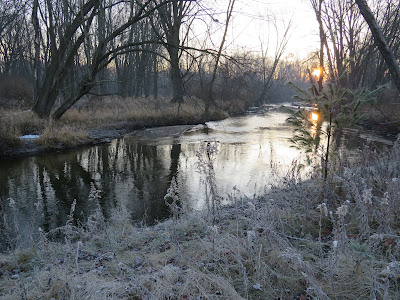It’s mostly sunny with freezing temperatures as I begin my early morning hike in the 14-acre Stearns Preserve, one of 25 preserves operated by the Chippewa Watershed Conservancy and the only one in Gratiot County. After admiring a Gibbous moon against azure blue skies, I proceed to the edge of the Pine River to watch its water flow gently through a pre-winter landscape. Moving up to the Meijer bike trail, I proceed east where I spot red berries of Viburnum and a few fading leaves of Honeysuckle, the only green foliage I can find. Continuing toward the bridge, I’m reminded of how different this view was on my hike back in June. Likewise, from the bridge, I look down to watch the river flow south through a stark landscape and compare this with the view I had back in June. Across the bridge, I make my way down a steep slope to the edge of the river, follow it upstream and turn to view the bridge from afar and compare it with the one I had back in June. Along the way, after ducking under thorns of Prickly-ash, I come upon a 12-inch stump displaying a variety of colors, including tiny Orange Cup fungi, pale green Foliose Lichens, black mold, green algae as well as white snow and ice. Back on the bike trail, I walk through a corridor of leafless Box Elder trees and recall doing the same thing back in the lush surroundings of June. Up ahead, I leave the paved path, descend a steep bank to the north and enter a landscape rarely seen in these parts. Referred to as a Rich conifer swamp or Cedar swamp, this groundwater-influenced, forested wetland is dominated by northern white cedar and thick layers of moss that insulate saturated soil. Due to anaerobic conditions associated with a high water table and organic soils, trees are shallowly rooted. As a result, leaning, bent, or fallen trees are common, creating tip-up mounds, abandoned root pits, and coarse woody debris. The complex community structure is further enhanced by root hummocks of cedar, which are often elevated above adjacent saturated or flooded organic soil. Cedar swamps provide a food source as well as sanctuary and shelter for dozens of species during winter, especially White Tail deer. During a severe winter with deep snow, swamp temperature is warmer, wind speeds are lower and the snow is shallower than the surrounding area. Back to the bike trail, heading for the car, I catch a quick glimpse of a Dark-eyed Junco in flight (lower left corner) with its white tail feathers.
River water
Gently flows
Seasons change
Nature knows
Barren bank
Green no more
Geese midstream
Icy shore
Rising sun
Clouds of gray
Morning hike
December day
D. DeGraaf

No comments:
Post a Comment